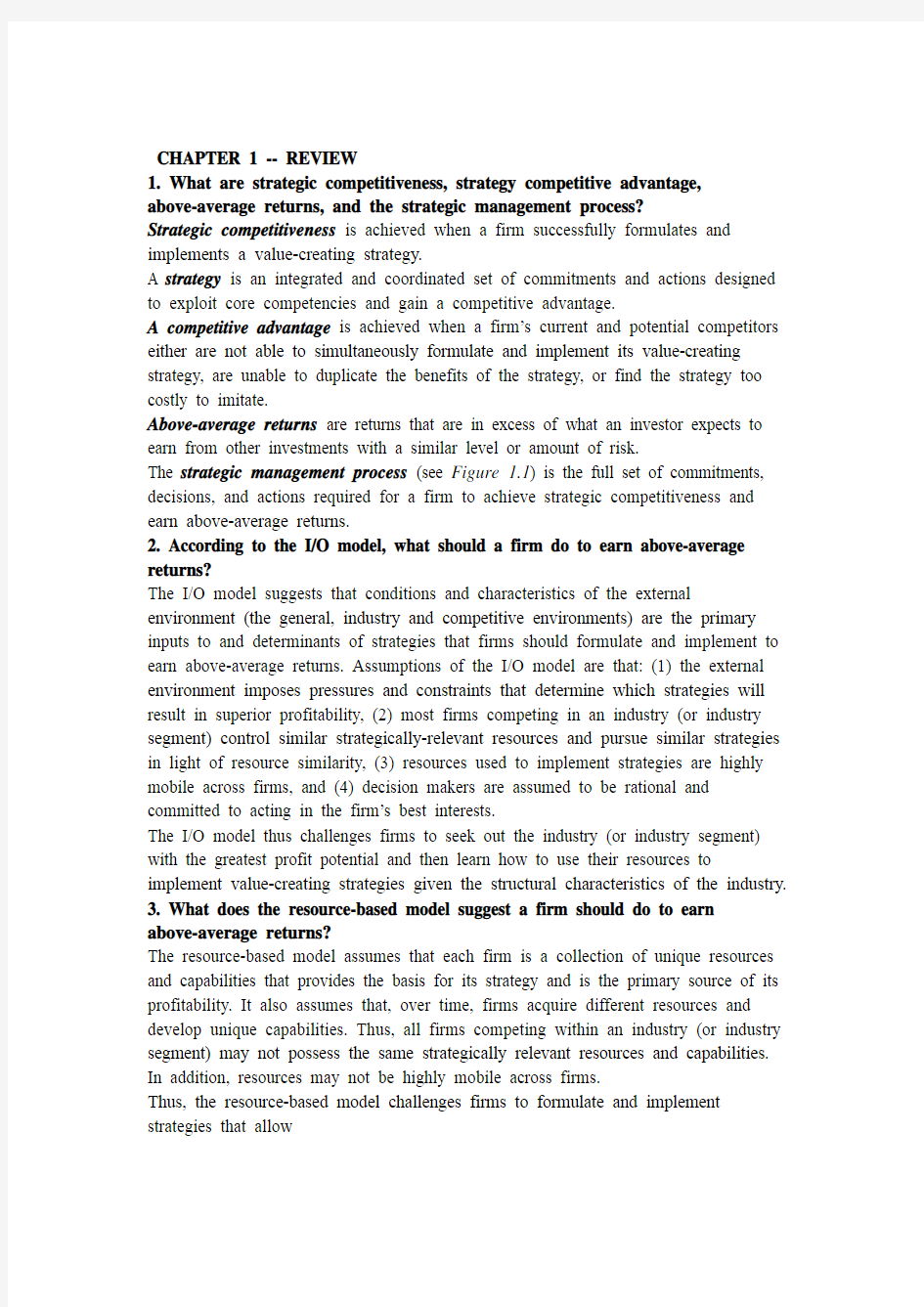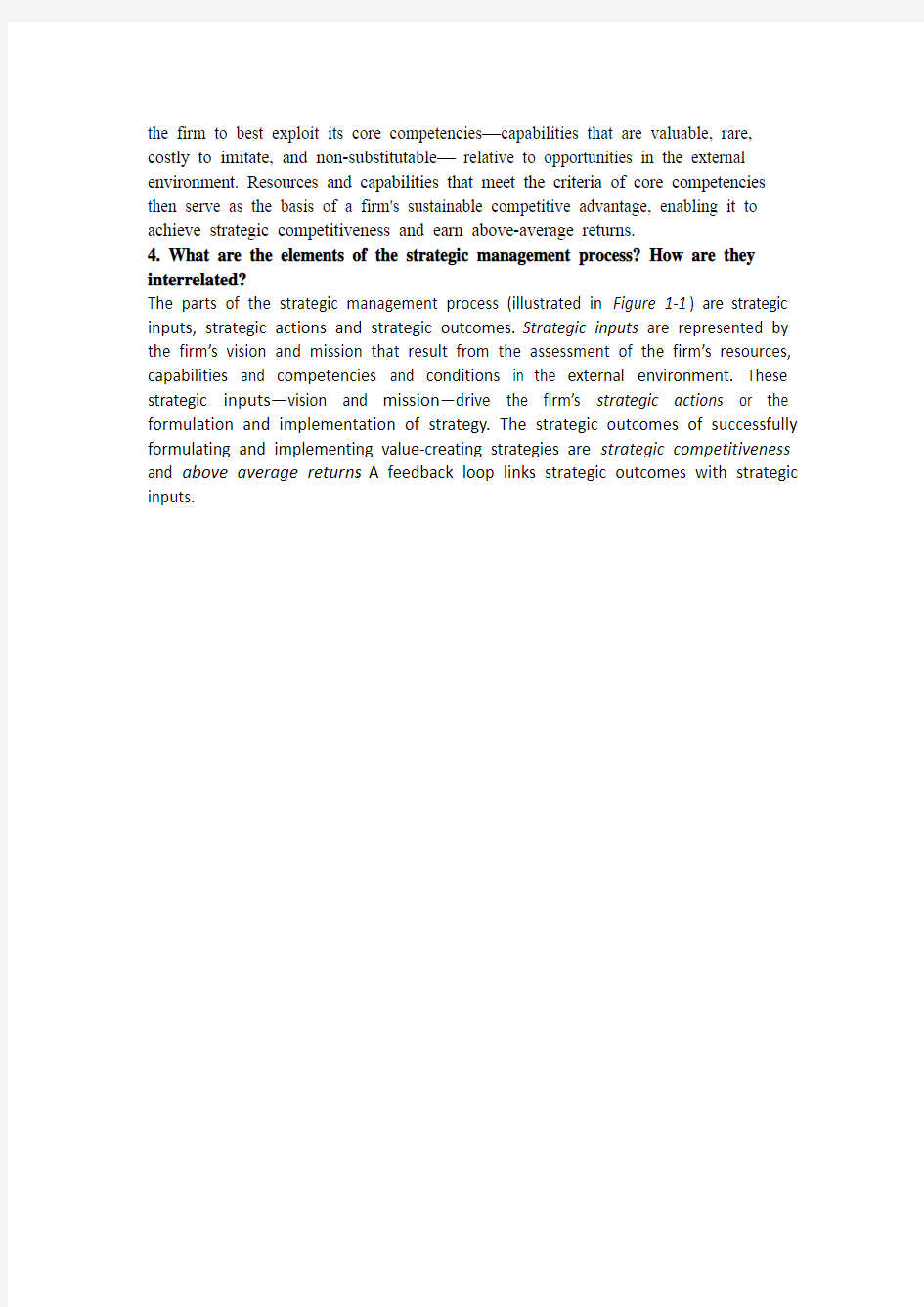战略管理课件


CHAPTER 1 -- REVIEW
1. What are strategic competitiveness, strategy competitive advantage,
above-average returns, and the strategic management process?
Strategic competitiveness is achieved when a firm successfully formulates and implements a value-creating strategy.
A strategy is an integrated and coordinated set of commitments and actions designed to exploit core competencies and gain a competitive advantage.
A competitive advantage is achieved when a firm’s current and potential competitors either are not able to simultaneously formulate and implement its value-creating strategy, are unable to duplicate the benefits of the strategy, or find the strategy too costly to imitate.
Above-average returns are returns that are in excess of what an investor expects to earn from other investments with a similar level or amount of risk.
The strategic management process (see Figure 1.1) is the full set of commitments, decisions, and actions required for a firm to achieve strategic competitiveness and earn above-average returns.
2. According to the I/O model, what should a firm do to earn above-average returns?
The I/O model suggests that conditions and characteristics of the external environment (the general, industry and competitive environments) are the primary inputs to and determinants of strategies that firms should formulate and implement to earn above-average returns. Assumptions of the I/O model are that: (1) the external environment imposes pressures and constraints that determine which strategies will result in superior profitability, (2) most firms competing in an industry (or industry segment) control similar strategically-relevant resources and pursue similar strategies in light of resource similarity, (3) resources used to implement strategies are highly mobile across firms, and (4) decision makers are assumed to be rational and committed to acting in the firm’s best interests.
The I/O model thus challenges firms to seek out the industry (or industry segment) with the greatest profit potential and then learn how to use their resources to implement value-creating strategies given the structural characteristics of the industry.
3. What does the resource-based model suggest a firm should do to earn
above-average returns?
The resource-based model assumes that each firm is a collection of unique resources and capabilities that provides the basis for its strategy and is the primary source of its profitability. It also assumes that, over time, firms acquire different resources and develop unique capabilities. Thus, all firms competing within an industry (or industry segment) may not possess the same strategically relevant resources and capabilities. In addition, resources may not be highly mobile across firms.
Thus, the resource-based model challenges firms to formulate and implement strategies that allow
the firm to best exploit its core competencies—capabilities that are valuable, rare, costly to imitate, and non-substitutable— relative to opportunities in the external environment. Resources and capabilities that meet the criteria of core competencies then serve as the basis of a firm's sustainable competitive advantage, enabling it to achieve strategic competitiveness and earn above-average returns.
4. What are the elements of the strategic management process? How are they interrelated?
The parts of the strategic management process (illustrated in Figure 1-1) are strategic inputs, strategic actions and strategic outcomes. Strategic inputs are represented by the firm’s vision and mission that result from the assessment of the firm’s resources, capabilities and competencies and conditions in the external environment. These strategic inputs—vision and mission—drive the firm’s strategic actions or the formulation and implementation of strategy. The strategic outcomes of successfully formulating and implementing value-creating strategies are strategic competitiveness and above average returns. A feedback loop links strategic outcomes with strategic inputs.
战略管理课件--简介
第一章
战略管理导论:战略与战略思维
XY
1
引子
?
?
有两个相互竞争的企业的老板希望通过野炊休闲的方式来讨论两家公 司是否合并的问题,在讨论过程中,双方各不相让,双方都坚信能战 胜对手。 突然森林中跑出来一个大黑熊,此时一个老板急忙打开旅行包,拿出 一双运动鞋穿上;另一位老板迷惑不解地问:“难道你穿上运动鞋就能 跑得过大黑熊吗?”这位老板回答说:“我不用跑过大黑熊,我只要跑 过你就行了。” 从这个幽默故事,你们知道一些什么道理……
?
13-Mar-12
2
本章学习目标
理解战略和战略管理的含义与战略的特征 明确战略管理的过程、任务与层次 了解战略管理的兴起与发展 了解战略管理的主要流派 领会两种战略思维模式
? ? ? ? ?
13-Mar-12
3
1.1 战略的含义与特征
?
1.
? ? ? ?
战略的涵义
“战”——战争、战斗 “略”——筹略、策划、计划 “战略”:在中国,起源于兵法,指将帅的智谋 《简明不列颠百科全书》:“在战争中利用军事手段达到战争目的 的科学和艺术。” 毛泽东:“战略问题是研究战争全局的规律性的东西。”
?
?
因此可以说,战略一词原是个军事方面的概念。
13-Mar-12
4
1.1 战略的含义与特征
?
20世纪60年代以来掀起了战略研究热潮
?
钱德勒(Alfred Chandler)1962年出版Strategy and Structure,首先 在企业管理中引入“战略”概念: “影响和决定企业的基本长期目
标与目的,选择企业达到既定目标所遵循的路线途径并就实现这 些目标和途径对企业已有资源进行优化配置。”
?
他把战略决策与业务决策区分开:
? ?
战略决策:基本目标,经营目标和方针,资源配置与调整 业务决策:保障资源的合理使用;日常经营管理
13-Mar-12
5
